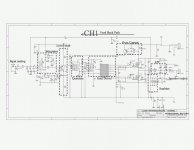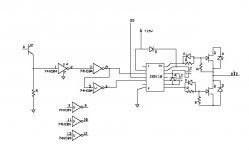class-d 200w@4ohm /osc 400K
this original pdf
http://www.irf.com/product-info/audio/classdtutorial.pdf

this original pdf
http://www.irf.com/product-info/audio/classdtutorial.pdf

The whole amp is an oscillator. This is an example of a self oscillating class D amplifier. Other examples are UcD, Mueta and ICE-power. Do a search on these to learn the difference between open loop class D amplifiers that use a fixed frequency sawtooth or triangle wave, that is compared to the input signal, and the self oscillating amplifiers that use a hysteresis controller to determine the approximate oscillating frequency.
It is explained also here: http://hem.passagen.se/johanps/audioexperiment/Amp0_5/DesignDescription_0_5.htm
Or even better: read the book 'High efficiency audio power amplifiers; design and practical use' from Ronan van der Zee, you can get the pdf for free! http://doc.utwente.nl/fid/1351
It is on page 48.
Steven
It is explained also here: http://hem.passagen.se/johanps/audioexperiment/Amp0_5/DesignDescription_0_5.htm
Or even better: read the book 'High efficiency audio power amplifiers; design and practical use' from Ronan van der Zee, you can get the pdf for free! http://doc.utwente.nl/fid/1351
It is on page 48.
Steven
I have built a self-oscillating Class D, that is to say, one without
a clock, and it worked fine. I have no reason to think it would
suffer from other than the ordinary limitations of Class D
amplifiers, which is to say switching speed, comparator
sensitivity, and output filtering.
a clock, and it worked fine. I have no reason to think it would
suffer from other than the ordinary limitations of Class D
amplifiers, which is to say switching speed, comparator
sensitivity, and output filtering.
Do a search on these to learn the difference between open loop class D amplifiers that use a fixed frequency sawtooth or triangle wave, that is compared to the input signal, and the self oscillating amplifiers that use a hysteresis controller to determine the approximate oscillating frequency.
You forgot the third principle: Those self-oscillating ones that use phase-shift for stable oscillation.
Regards
Charles
Given the latest incarnations of self-oscillating designs like Philips UCD it looks as if the performance/complexity ratio is definitley better for the self-oscillating designs.
One advantage of the carrier based designs is that they can be accurately run at a specific frequency. This has advantages when the input signal is coming from a D/A converter using only marginal output filtering. The other advantage is the possible use of notch filters in order to get rid of the output ripple.
I once designed a carrier-based class-d amp that had a carrier suppression of more than 80 dB that way.
Regards
Charles
One advantage of the carrier based designs is that they can be accurately run at a specific frequency. This has advantages when the input signal is coming from a D/A converter using only marginal output filtering. The other advantage is the possible use of notch filters in order to get rid of the output ripple.
I once designed a carrier-based class-d amp that had a carrier suppression of more than 80 dB that way.
Regards
Charles
Hi,
has anyone had any luck downloading that book at
http://doc.utwente.nl/fid/1351 ??
I get the first page and then it just hangs.
Thanks,
Chris
has anyone had any luck downloading that book at
http://doc.utwente.nl/fid/1351 ??
I get the first page and then it just hangs.
Thanks,
Chris
HI bellx
I think you confused with class-AB & class-D amplifier,Is you
need more power you must increased voltage, one pair mosfet is
enough to drive up to 1 kw on half bridge configuration,so now I just
strat my class-D amplifier project,voltage +/- 130-150v ,mosfet use
irf450 ,power supply user ETD 49 CORE with ir2153 self oscillation
driver can up to 400W /4 ohm,but power supply design is not completed
I think you confused with class-AB & class-D amplifier,Is you
need more power you must increased voltage, one pair mosfet is
enough to drive up to 1 kw on half bridge configuration,so now I just
strat my class-D amplifier project,voltage +/- 130-150v ,mosfet use
irf450 ,power supply user ETD 49 CORE with ir2153 self oscillation
driver can up to 400W /4 ohm,but power supply design is not completed
GEORGE HO said:HI bellx
I think you confused with class-AB & class-D amplifier,Is you
need more power you must increased voltage, one pair mosfet is
enough to drive up to 1 kw on half bridge configuration,so now I just
strat my class-D amplifier project,voltage +/- 130-150v ,mosfet use
irf450 ,power supply user ETD 49 CORE with ir2153 self oscillation
driver can up to 400W /4 ohm,but power supply design is not completed
Hi,
IRF450.....500V, 13 amps? RdsOnb .4ohms....seems kind of high..if you doubled them up...you could have 26 amps.... 0.2ohms...which still seems high, but there is at least a reason for doing it.
Bit harder to drive though.
I think the prefered solution seems to be, find a better mosfet, which can be a real pain, but in the end the payoff is large.
Your amp sounds interesting...I'd like to know how that controller works for you.
Good luck,
Chris
classd4sure said:Hi,
has anyone had any luck downloading that book at
http://doc.utwente.nl/fid/1351 ??
I get the first page and then it just hangs.
Thanks,
Chris
No problem at all. Just tried again and received all 128 pages.
Steven
Hi Steven,
I'm still unable to download it today...same thing I get the first page and it hangs, not a problem I usually have.
It's alright though I had a friend try the link out and he was able to download it for me and sent it over.
Thanks for the link it's a great read.
Chris
I'm still unable to download it today...same thing I get the first page and it hangs, not a problem I usually have.
It's alright though I had a friend try the link out and he was able to download it for me and sent it over.
Thanks for the link it's a great read.
Chris
- Status
- This old topic is closed. If you want to reopen this topic, contact a moderator using the "Report Post" button.
- Home
- Amplifiers
- Solid State
- How This Circuit Works

